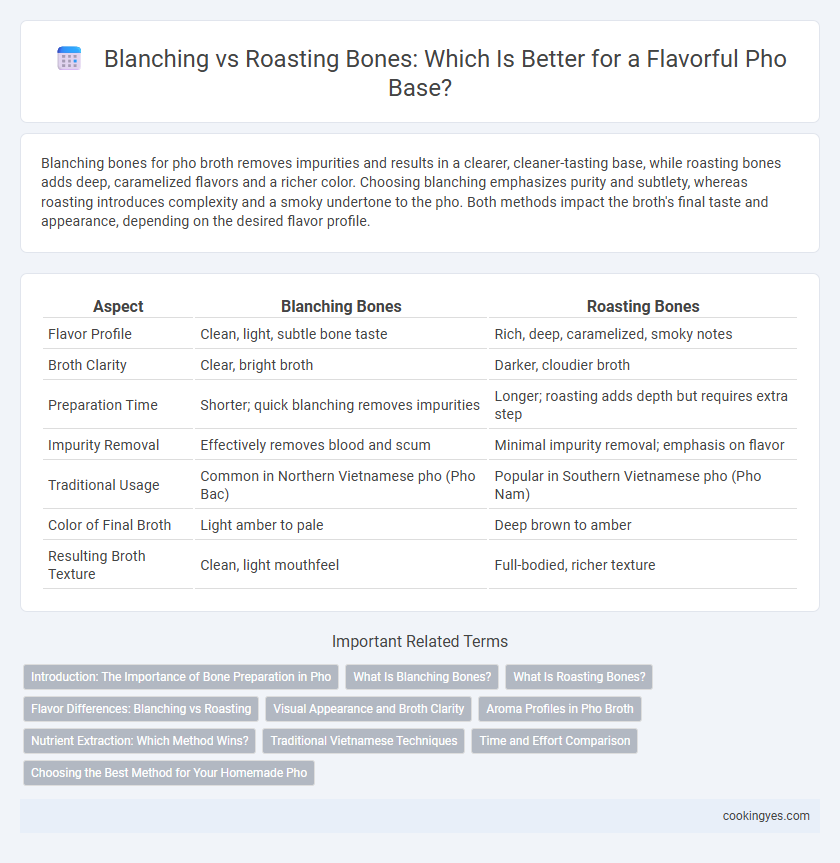Blanching bones for pho broth removes impurities and results in a clearer, cleaner-tasting base, while roasting bones adds deep, caramelized flavors and a richer color. Choosing blanching emphasizes purity and subtlety, whereas roasting introduces complexity and a smoky undertone to the pho. Both methods impact the broth's final taste and appearance, depending on the desired flavor profile.
Table of Comparison
| Aspect | Blanching Bones | Roasting Bones |
|---|---|---|
| Flavor Profile | Clean, light, subtle bone taste | Rich, deep, caramelized, smoky notes |
| Broth Clarity | Clear, bright broth | Darker, cloudier broth |
| Preparation Time | Shorter; quick blanching removes impurities | Longer; roasting adds depth but requires extra step |
| Impurity Removal | Effectively removes blood and scum | Minimal impurity removal; emphasis on flavor |
| Traditional Usage | Common in Northern Vietnamese pho (Pho Bac) | Popular in Southern Vietnamese pho (Pho Nam) |
| Color of Final Broth | Light amber to pale | Deep brown to amber |
| Resulting Broth Texture | Clean, light mouthfeel | Full-bodied, richer texture |
Introduction: The Importance of Bone Preparation in Pho
Proper bone preparation is crucial for a rich and flavorful pho broth, with blanching and roasting as two primary methods. Blanching bones removes impurities and results in a clearer, cleaner broth, while roasting enhances depth with caramelized, savory notes. Selecting the right technique depends on the desired flavor profile, clarity, and authenticity of the pho base.
What Is Blanching Bones?
Blanching bones involves briefly boiling them before making pho broth to remove impurities and achieve a clearer, cleaner flavor. This process helps eliminate blood, scum, and excess fat, resulting in a lighter, more refined soup base compared to roasting. While roasting bones adds deeper, caramelized flavors, blanching ensures the pho broth maintains its traditional delicate and subtle taste profile.
What Is Roasting Bones?
Roasting bones for pho base involves cooking beef or pork bones at high heat until they develop a deep brown color and rich aroma, which enhances the broth's flavor complexity and adds a caramelized, smoky depth. This Maillard reaction transforms the bones' surface, intensifying the umami profile essential for authentic pho broth. Unlike blanching, which cleanses impurities by boiling bones briefly, roasting builds a robust, flavorful foundation crucial for achieving pho's signature taste.
Flavor Differences: Blanching vs Roasting
Blanching bones for pho broth results in a cleaner, lighter flavor by removing impurities and excess fat, preserving the subtle sweetness of the beef or pork bones. Roasting bones enhances depth and richness through caramelization and Maillard reactions, creating a more robust, complex broth with toasty, savory undertones. Choosing between blanching and roasting directly impacts the pho base's flavor profile, balancing clarity versus intensity.
Visual Appearance and Broth Clarity
Blanching bones for pho broth results in a lighter color and enhanced clarity, as impurities and blood are expelled before simmering, reducing cloudiness in the final broth. Roasting bones imparts a deeper amber hue and richer flavor but can create a slightly murkier broth due to caramelization and rendered fat. Clear, visually appealing pho typically relies on blanching to achieve a transparent and clean-looking broth essential for presentation.
Aroma Profiles in Pho Broth
Blanching bones for pho broth results in a cleaner, milder aroma with subtle umami notes, enhancing the clarity of the broth without overpowering other ingredients. Roasting bones intensifies the aroma profile by releasing caramelized, nutty, and smoky flavors that add depth and richness to the pho base. Balancing these techniques can create a complex, fragrant broth with layers of savory and aromatic nuances essential to authentic Vietnamese pho.
Nutrient Extraction: Which Method Wins?
Blanching bones for pho broth helps remove impurities and reduces bitterness while preserving delicate nutrients like collagen and minerals, resulting in a clearer, cleaner base. Roasting bones enhances flavor through Maillard reactions, producing a deeper, richer taste but can cause some nutrient loss due to high heat exposure. For optimal nutrient extraction, blanching is generally preferred as it maintains more bioavailable proteins and minerals essential for a nourishing pho base.
Traditional Vietnamese Techniques
Traditional Vietnamese pho broth relies on blanching bones to remove impurities and achieve a clear, delicate flavor, preserving the authentic taste sought in classic recipes. Roasting bones imparts a deeper, caramelized richness but diverges from the customary pho profile favored in northern Vietnam, where transparency and subtlety define the broth. Selecting blanching maintains the broth's clean appearance and light aroma, essential for replicating traditional pho's signature balance.
Time and Effort Comparison
Blanching bones for pho broth typically requires about 10-15 minutes and minimal hands-on effort, as it mainly involves boiling the bones briefly to remove impurities before simmering. Roasting bones, however, demands 30-45 minutes to achieve a deep caramelization that enhances flavor, coupled with more active attention to prevent burning. While blanching is quicker and simpler, roasting bones offers a richer, more complex broth but requires greater time and skilled handling.
Choosing the Best Method for Your Homemade Pho
Choosing between blanching and roasting bones for your pho base significantly impacts the broth's flavor and clarity. Blanching removes impurities and results in a clearer, cleaner broth, ideal for a delicate and light pho. Roasting bones enhances caramelization and depth, yielding a richer, more robust broth that intensifies traditional pho flavors.
Blanching bones vs roasting bones for pho base Infographic

 cookingyes.com
cookingyes.com